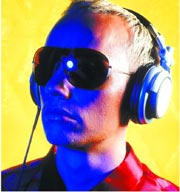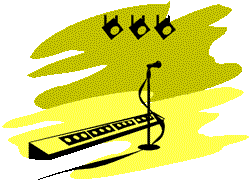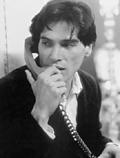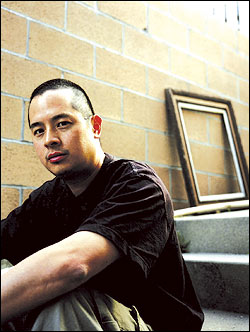IN THE EARLY ’90S, jungle was strictly a London thing. Few if any DJs or producers of note hailed from anywhere else—especially not America, where neither acid house euphoria nor Jamaican dancehall attitude, two key elements of jungle’s DNA, ever culturally rooted themselves as deeply as they had in England. But a handful of Americans were listening—in particular, a college student named Damian Higgins, a.k.a. DJ Dieselboy.
Dieselboy
Stadium Exhibition Center, Saturday, January 27, and Rain Dancer, Sunday, January 28
Now, drum-and-bass, as it’s become more widely known, is global, albeit on a cult level rather than a mass scale. But if it’s taken root in America, it’s due in healthy part to Dieselboy. A decade after Higgins began mixing the mysterious imported music into his sets at Pittsburgh’s first raves, he’s the best-known drum-and-bass proselytizer in the country. Even more impressive, he’s also won serious respect abroad, named co-winner in the “Best Drum and Bass DJ” category with LTJ Bukem at 1998’s Global Mix DJ Awards.
And he remains a tireless worker. Take this weekend: In addition to headlining Crescent, Saturday’s rave at the Stadium Exhibition Center, he’ll also appear the following evening at Dark Fusion, the weekly drum-and-bass session at Rain Dancer. He’s mixed half a dozen CDs, ranging in style from 1997’s raw, hip-hop-infused Drum and Bass Selection USA to the funky, squelching, wah-pedaled-out bass lines of 1999’s A Soldier’s Story to the rampaging techstep of last spring’s System Upgrade; October saw the release of The 6ixth Session on Palm Pictures.
“A lot of times, a [rave] promoter will bring me in and say, ‘We’ve never had drum-and-bass in the main room,'” Higgins relates from his current home in Philadelphia. “Some cities are really rooted in house music, and it’s taken them a long time to allow drum-and-bass to get a foothold in the scene. So it’s really cool to experiment, to be the first guy out there in that city trying to push it onto people.”
Pushing the music onto his fellow Pittsburghers during jungle’s—and rave’s—embryonic stages in the States proved surprisingly easy. “From early on, Pittsburgh was always really open to it,” he says. “I was DJing a little when that stuff started coming out in ’91, just doing little parties with CDs.”
A couple of fellow Pittsburgh DJs, Deadly Buda and Controlled Weirdness, provided Higgins’ entr饠into the world of mixing vinyl and throwing semi-legal warehouse events. Though everything from soulful house to hard, bombastic techno made its way into his early sets, Higgins soon found himself drawn most heavily toward the wave of white-label 12-inches he was buying from Controlled Weirdness’ sister, who ran a record shop in England. “I remember going to parties and having no idea what they were playing; I still don’t know what some of those records were,” he says. “They were just amazing.”
ONCE HIGGINS had established his name on the Eastern seaboard, he found himself traveling the country most weekends, still managing to finish college and hold a day job in tech support. Shortly after graduating three and a half years ago, however, Higgins received an invitation from a friend, Philadelphia techno DJ Nigel Richards, to live in his house and work at his store, 611 Records.
Higgins still does both, and he also retains a feel for the old-school breakbeat hardcore that fired his DJ passion, something The 6ixth Session demonstrates. The mix contains the industrial squish that’s been a drum-and-bass mainstay since techstep’s emergence, but it’s tempered by a rolling, rhythmic velocity that feels something like golden-age jungle with an updated vibe.
“There’s an old school revival that’s been going on for about a year,” Higgins says. “Producers like Digital are doing things that haven’t been released yet that sound like old ’92-’95 tracks—only sped up to the current speed, around 170 beats-per-minute. People were getting darked out by all the techstep.”
While The 6ixth Sense does sometimes wallow in dystopian futurismo (most effectively on tracks like Technical Itch’s “Pusher,” which evokes bubbles in a vat of molten steel, or the scissoring snares and hi-hats that run through Loxy + Dylan’s “Eclipse”), it’s the disc’s final song that points a way forward. J. Majik’s “Solarize” moves the mix out of the dark and into a funky, dawn-coming-up hyperdrive that’s as close to Goa trance as it is to drum-and-bass.
Higgins is pleased with the results. “It’s got a hard element to it, but it’s also pretty ethereal. I always try to include at least one tune that’s on the atmospheric/melodic tip. J. Majik had just finished that song a few days before I called, so it was brand-new.”
But as with any workaholic, Higgins is most excited about his next project—in this case, his second DJ-mix for Palm Pictures. “With all the old-school vibe coming up, the next CD should be a lot more varied,” he promises. “I don’t like to repeat the same thing if I can help it.”








